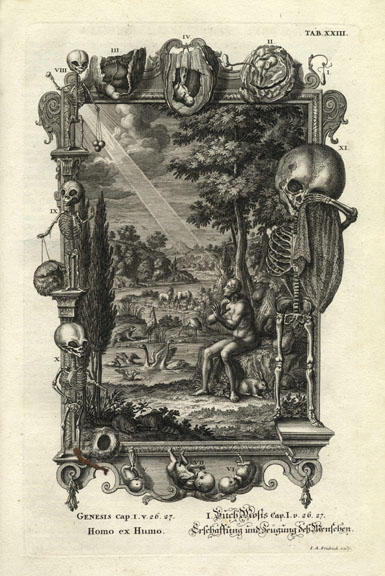"How is it possible to understand the whole universe? All the books that are made treat only some of the imaginable topics. What could we read that would treat absolutely everything?"
So wrote François de Grenaille, author of Theatre de l'universe, published in 1643. Scholars had expressed similar consternation for a full century. With the advent of the printing press, the sheer volume of books reached what many scholars considered crisis levels—they were simply unable to keep up with so much new information.
Indeed, the early modern period saw an explosion of information, and scholars struggled to find ways to assimilate it all. Some of these methods may seem absurd by today's standards (such as Agostino Ramelli's 1588 conceptualization of a book wheel that would simultaneously hold up to 70 books open for comparison), but other methods have evolved to support and promote learning even today.
Early modern scholars faced layers of challenges in their quest for knowledge. First, discrete academic disciplines had yet to emerge, so learned men sought a seemingly impossible level of omnicompetence. Second, they lacked a formalized infrastructure for assimilating vast quantities of new information. And finally, scientific discoveries frequently conflicted with biblical teachings, resulting in tension between the scientific community and the Church.
It's no wonder, then, that the biblical encyclopedia emerged as a means of addressing these challenges. While Scheuchzer's Physica Sacra certainly falls into the category of biblical encyclopedias, Scheuchzer also broke new ground by reconceptualizing the genre.
Early Lists and a Biblical Encyclopedia: Johann Heinrich Alsted
One hallmark of the seventeenth-century intellectual landscape was indefatigable list-making. Few scholars of the era were more accomplished at list-making than German logician Johann Heinrich Alsted (1588-1638). He turned his attention to creating knowledge maps of virtually every conceivable topic of his time, that is, any topic that appeared in Scripture. The Bible, then, helped Alsted to limit his scope, which was the conventional approach of a biblical encyclopedia. Alsted would go on to write in his 1625 Triumph of the Sacred Book, or, the Biblical Encyclopedia, "There is no book but Sacred Scripture."
Alsted published an expanded version of that encyclopedia in 1630, though he seemed utterly unconcerned with creating a comprehensive or thorough reference. By contemporary standards, Alsted's encyclopedias seem woefully superficial. For example, he merely lists the types of animals that exist and makes little attempt to describe them. But he believed the Bible an endless source and noted that "something always can be added from the inexhaustible spring of the Scriptures."
Samuel Bochart's Efforts
Samuel Bochart took a slightly different approach, using the Bible as a guide for breaking knowledge into different domains. Bochart conceded in his Geographia Sacra that "we are not capable of everything. To know everything is for God alone." He also admitted in his dedication of Hierozoicon (1663), a two-part work on animals of the Bible, "Because truth cannot differ from truth, I am moved to reconcile the philosophers with the prophets." Like Alsted, Bochart recognized the futility of containing all knowledge in one book, so he used the Bible to impose limitation and focus.
Other Biblical Commentaries
Even as Alsted and Bochart worked on their encyclopedias, more and more information was accumulating about the Bible and the biblical world. While scholars had previously satisfied themselves with merely studying the Bible as a text, they now had a wealth of knowledge at their fingertips thanks to archaeological discoveries and exploration.
Some of Alsted and Bochart's contemporaries tried moving beyond the biblical encyclopedia to simple compilation. Notable efforts in this approach include John Pearson, whose compilation of biblical commentaries, Critici Sacri (1660), reached a whopping nine volumes. Reverend Matthew Poole worked for ten years on his Synopsis Criticorum (1669), which ran to five volumes. The sheer length of these works illustrated not only their editors' impressive scholarship, but also the still-unsolved problem of endlessly expanding information.
Johann Jakob Scheuchzer's Physica Sacra
At first glance, Johann Jakob Scheuchzer's Physica Sacra doesn't really seem to push the envelope as a biblical encyclopedia. Though it's certainly more exhaustive than Alsted and Bochart's works, it still uses the Bible as a foundation. And originally published as four folio volumes, the Physica Sacra is no less voluminous than Poole's massive work (especially when you consider that it also contains over 760 incredible copper plate engravings).
But Scheuchzer aspired to a different kind of scholarship and really a different kind of work entirely. While his intellectual predecessors had used the Bible to limit their scope, Scheuchzer used it as a starting point. He sought to combat the "language and word dabbling" and tendency toward "mystical and allegorical explanation" that he saw as all too common in biblical study. And where other biblical encyclopedias simply explained the Bible, Scheuchzer undertook to explain the natural world.
The Physica Sacra starts with Genesis and moves methodically through stories of the Bible. Lush illustrations punctuate the text, as do exhaustive annotations. One of the most memorable illustrations is Homo ex homo, which accompanies Genesis 1:26. Adam has just found himself in Paradise, and he looks about him in wonder. Scheuchzer frames that biblical creation image with illustrations of human development, from the egg to embryo to fetus. For this Scheuchzer borrows the image of a weeping fetal skeleton "bemoaning human sorrow" from Dutch physician Frederik Ruysch. Scheuchzer makes no attempt to reconcile the scientific and anatomical facts of creation with the biblical account. He simply presents all the information that he deems relevant to either.
Scheuchzer takes a similar approach with his discussion of the Tower of Babel, delving into the logistics of building such a massive structure and possible motivations for its construction. He presents differing theories for the building's shape (pyramid or cone) and includes a diagram of measurements to help visualize the various general principles that would apply to the Tower's construction. Scheuchzer even calculates that it would have taken precisely 1,763,128 workers to build the tower—which would have represented one-fifth of the world's entire population at the time.
Despite these apparent impossibilities, Scheuchzer rarely makes partisan statements. Where his predecessors often openly espoused one religious doctrine, Scheuchzer seemed happy in his self-appointed role as arranger of information. That refusal to make distinctions also manifests in the breadth of his citations, found not only in the text but also buried in his illustrations (which were "borrowed" from Ruysch, Andreas Vesalius, Antoni Van Leeuwenhoek, and a host of others).
Since Scheuchzer refused to subordinate either the Bible or science, virtually anything could be included in his encyclopedia. Thus, he effectively made the Bible a starting point to address any topic he saw fit. Meanwhile the Bible was also a text with which his contemporaries would undoubtedly be quite familiar, so the biblical foundation provided reliable guideposts for his audience. Scheuchzer could assume that any reader of his age would be familiar with, say, the story of Noah's ark. From there, Scheuchzer could then discuss mathematical or architectural principles relevant to building the ark. He could also talk about the species of animals on the ark, the geological impact of a flood...the list of possible topics is quite long, and that's only one Bible story.
What Sets Scheuchzer Apart?
This is really what sets Scheuchzer apart from his colleagues and predecessors: he actually placed the Bible alongside other human knowledge, rather than above it. Therefore Scheuchzer's Physica Sacra truly represents a fundamental shift in how the Bible was considered in the 1700s. By the end of that century, the Bible had transitioned from a book about God, to a book about humanity.
Academic disciplines as we recognize them today began to emerge in earnest by the early 19th century. In many ways, this resolved the early modern problem of information assimilation: once one could specialize, one could also pay less heed to information outside one's area of specialty. Soon specialty dictionaries and encyclopedias gained widespread popularity, and they remain beloved among rare book collectors today. But as a work of omnicompetence, Scheuchzer's Physica Sacra remains an irreplaceable artifact of the original Information Age.











